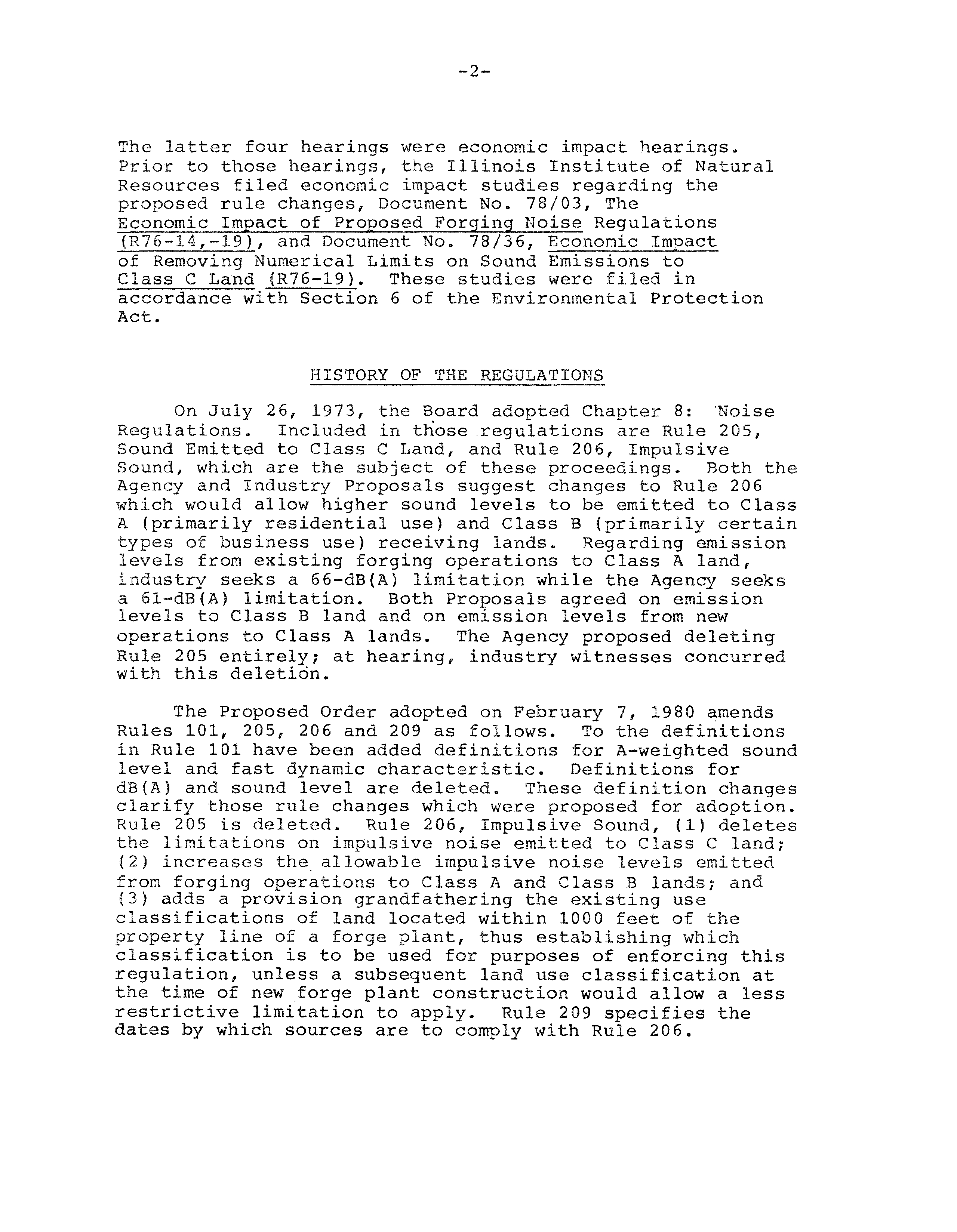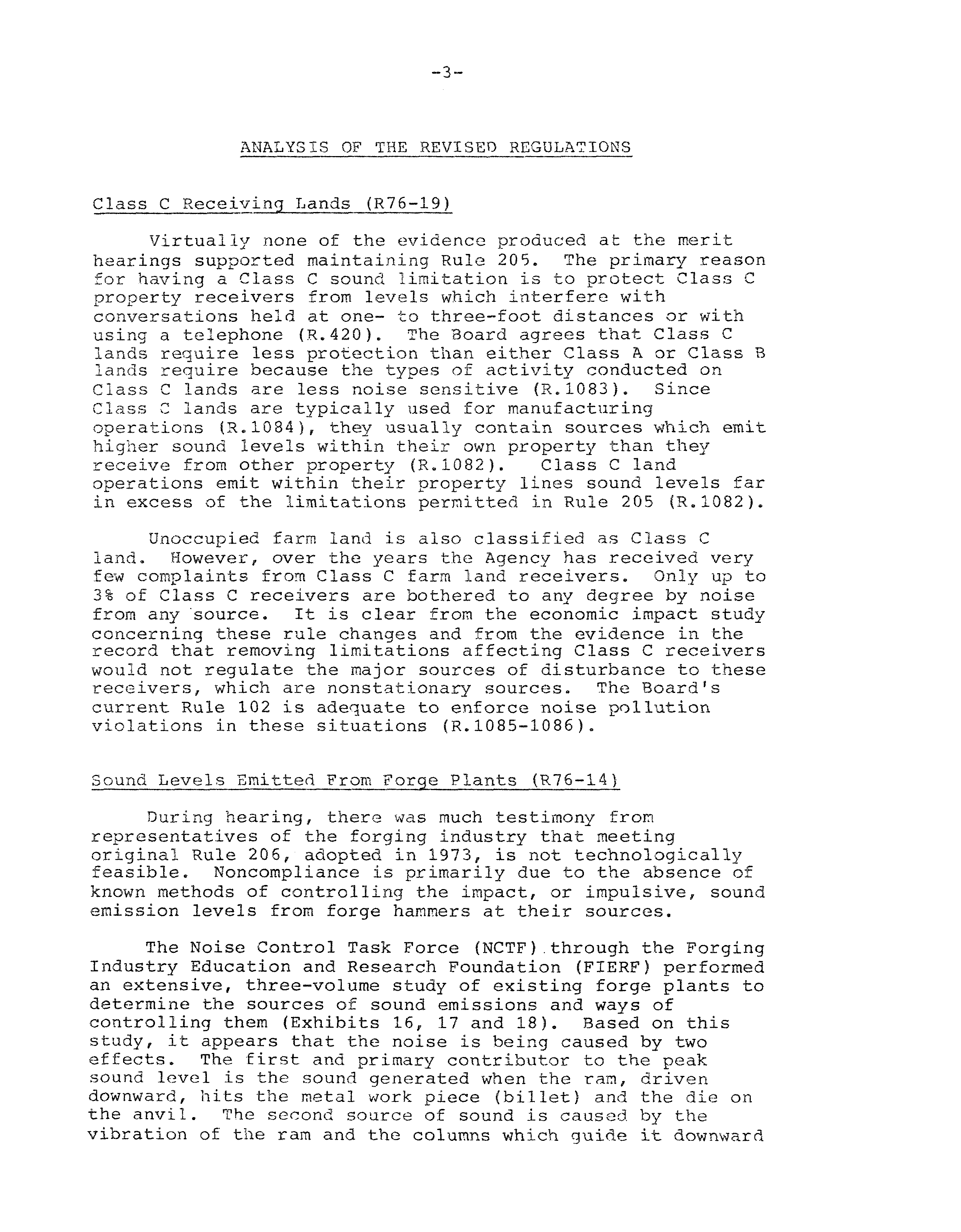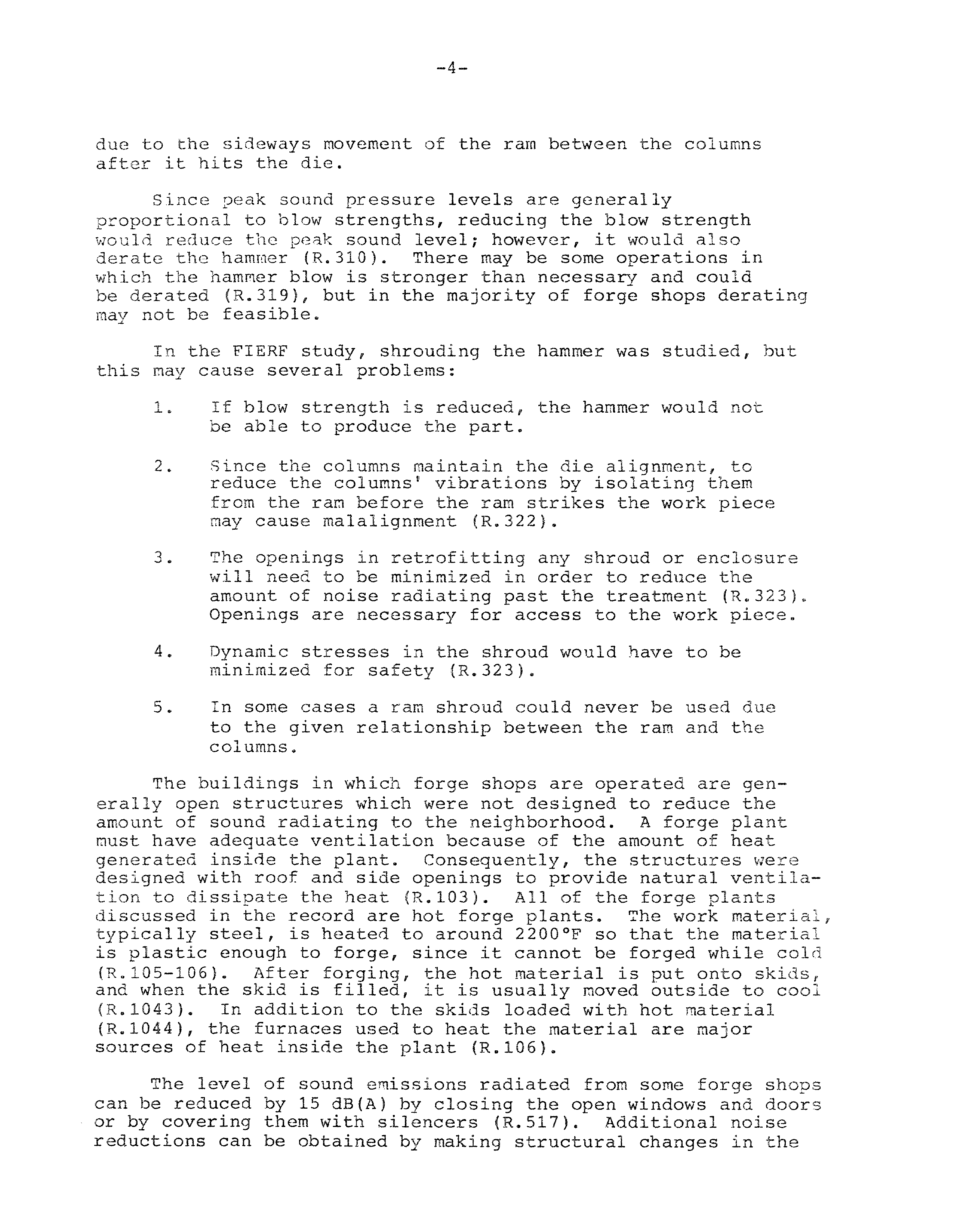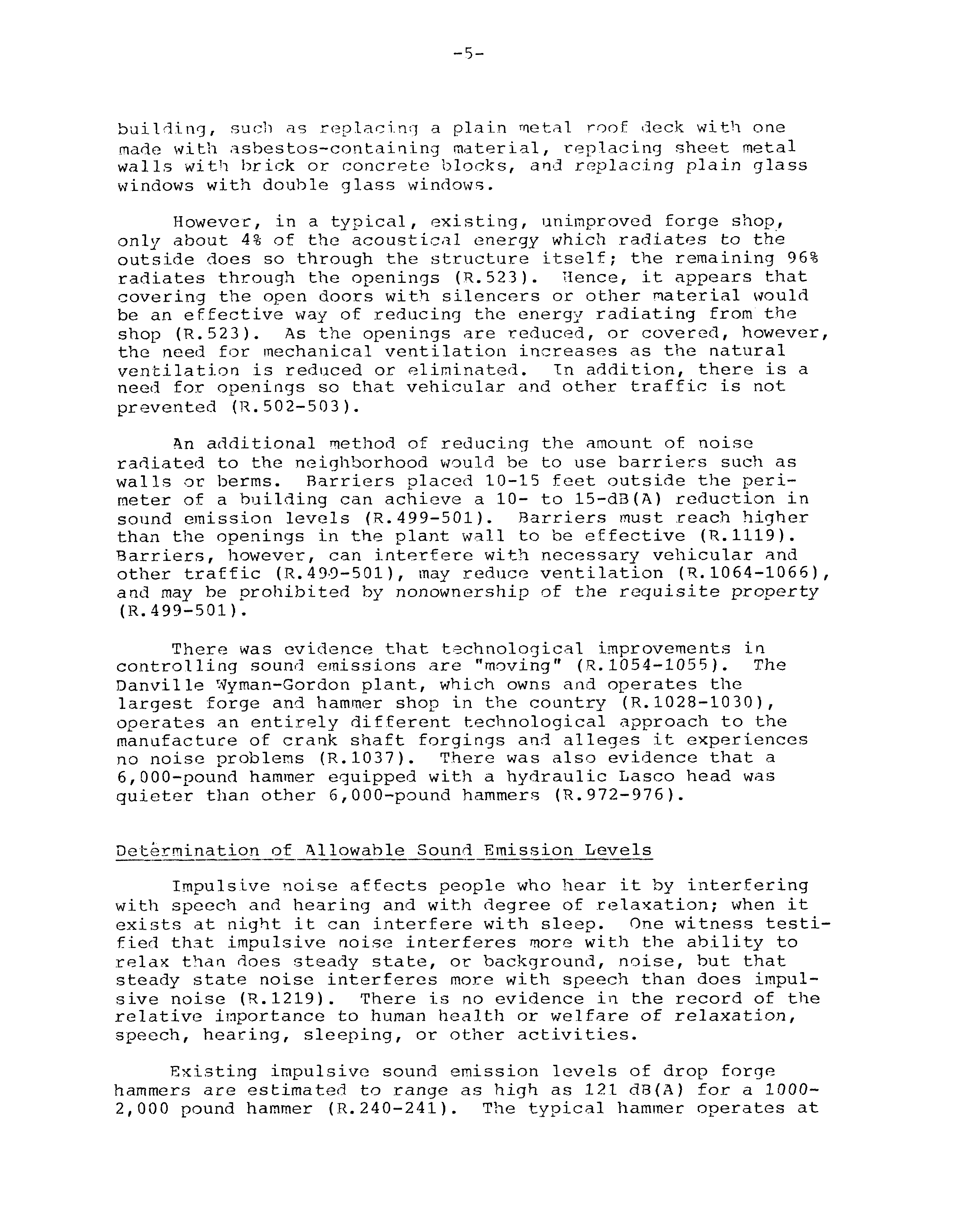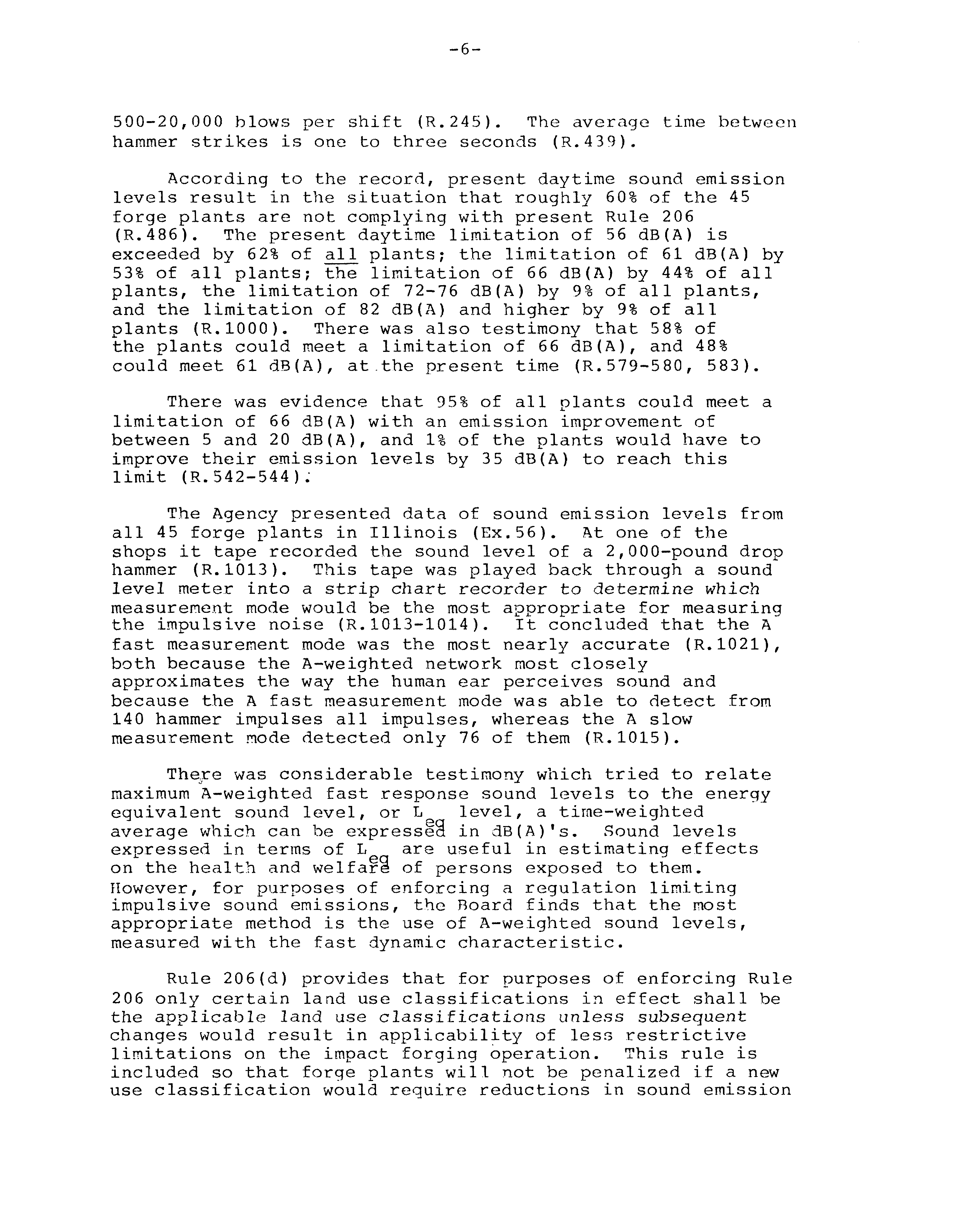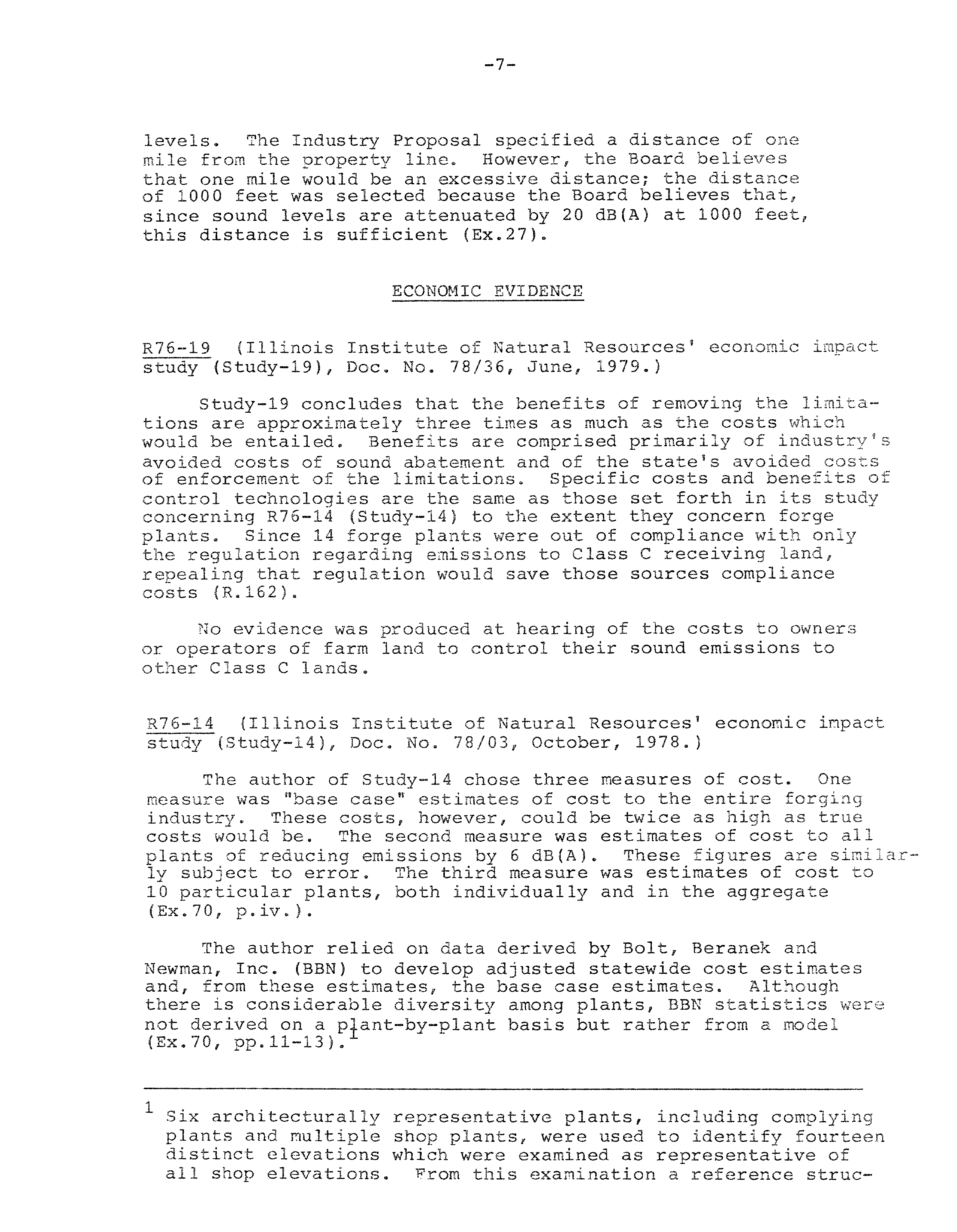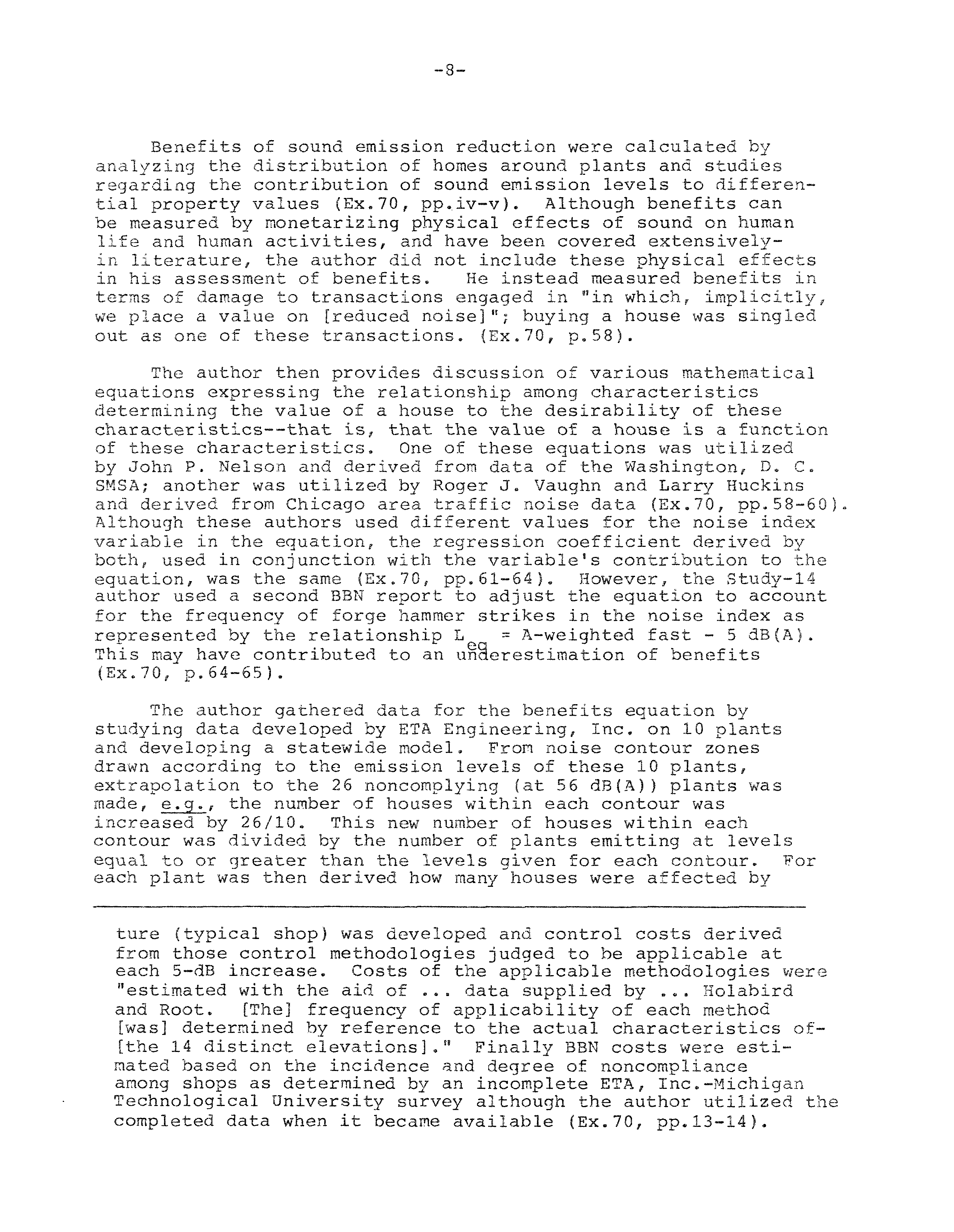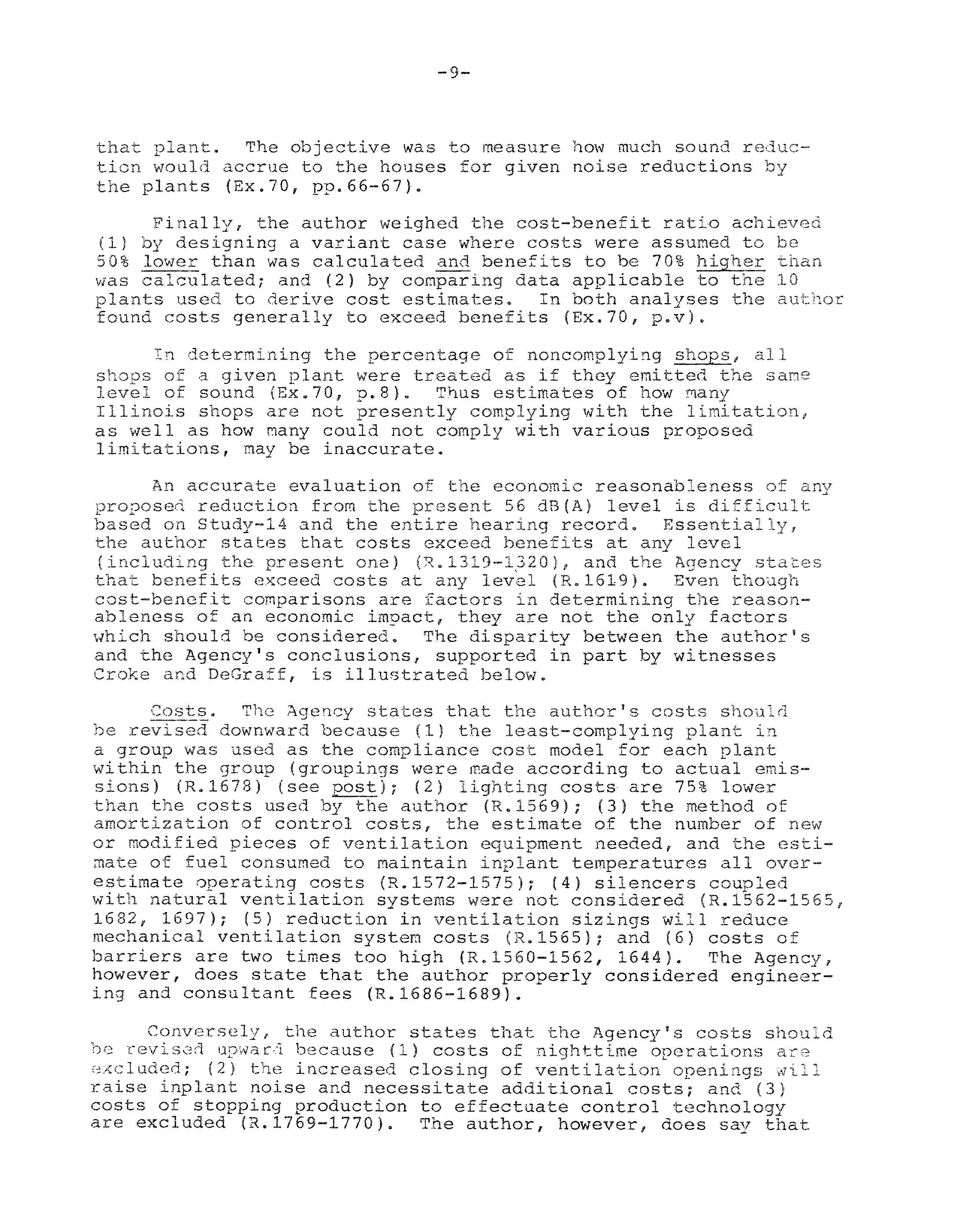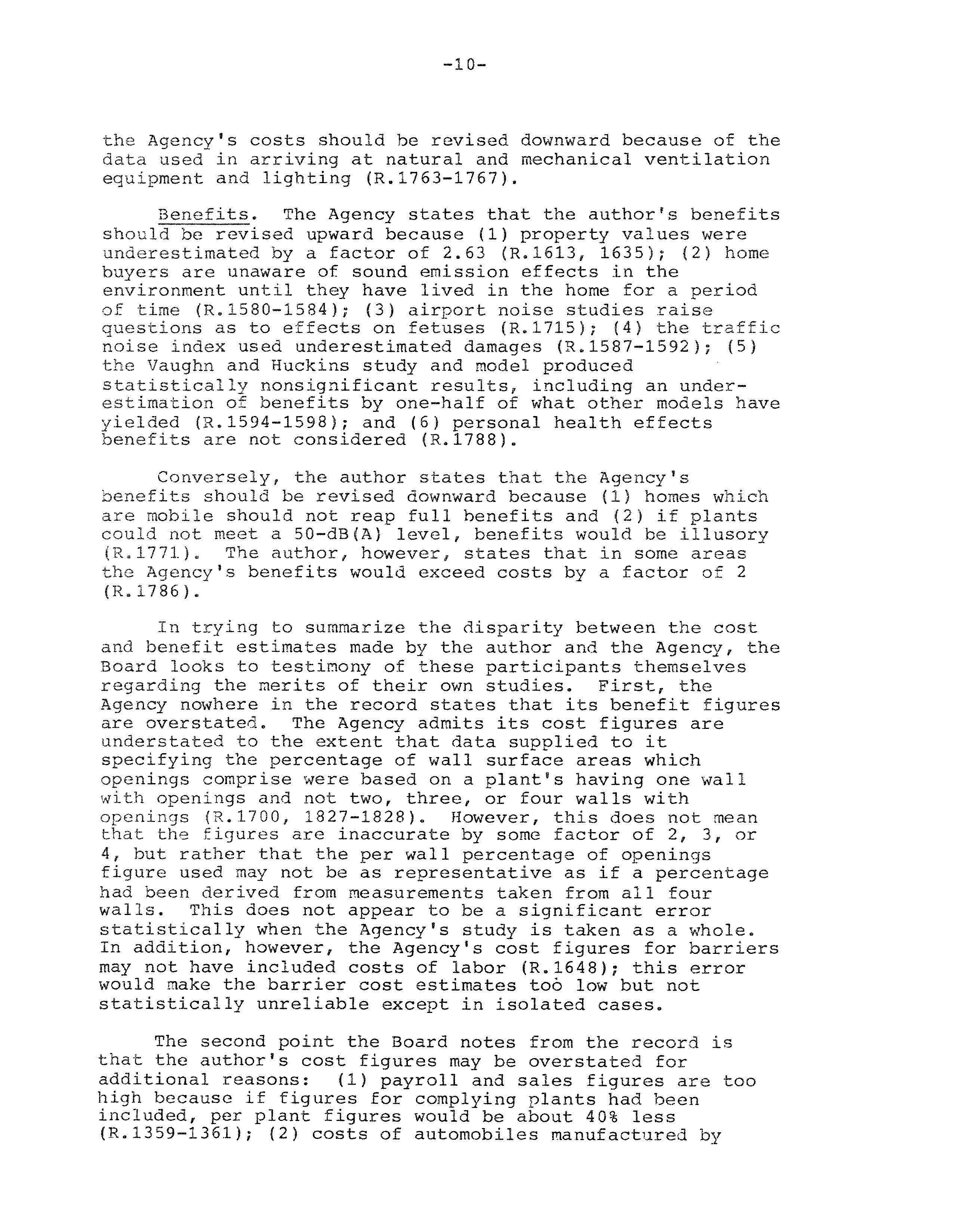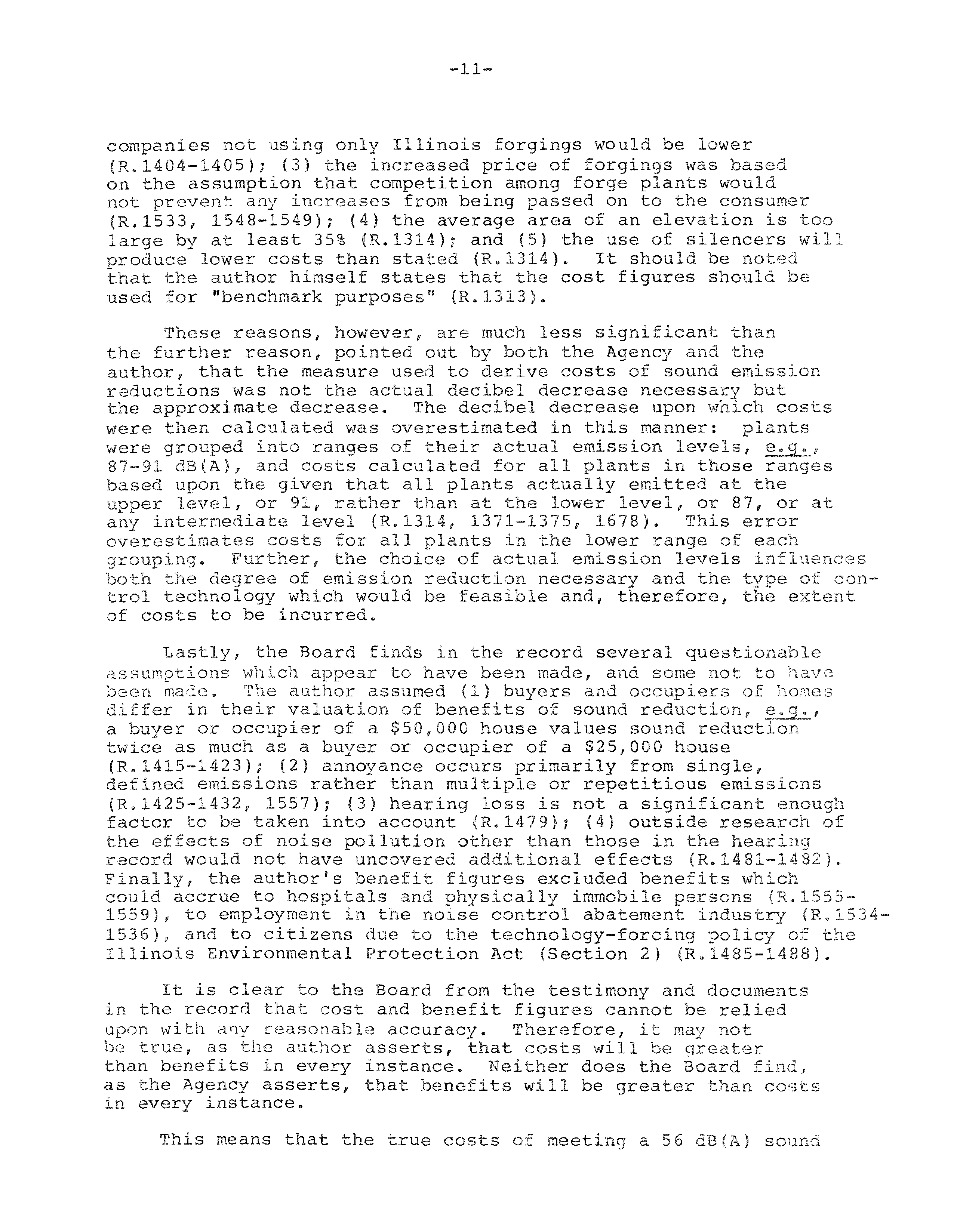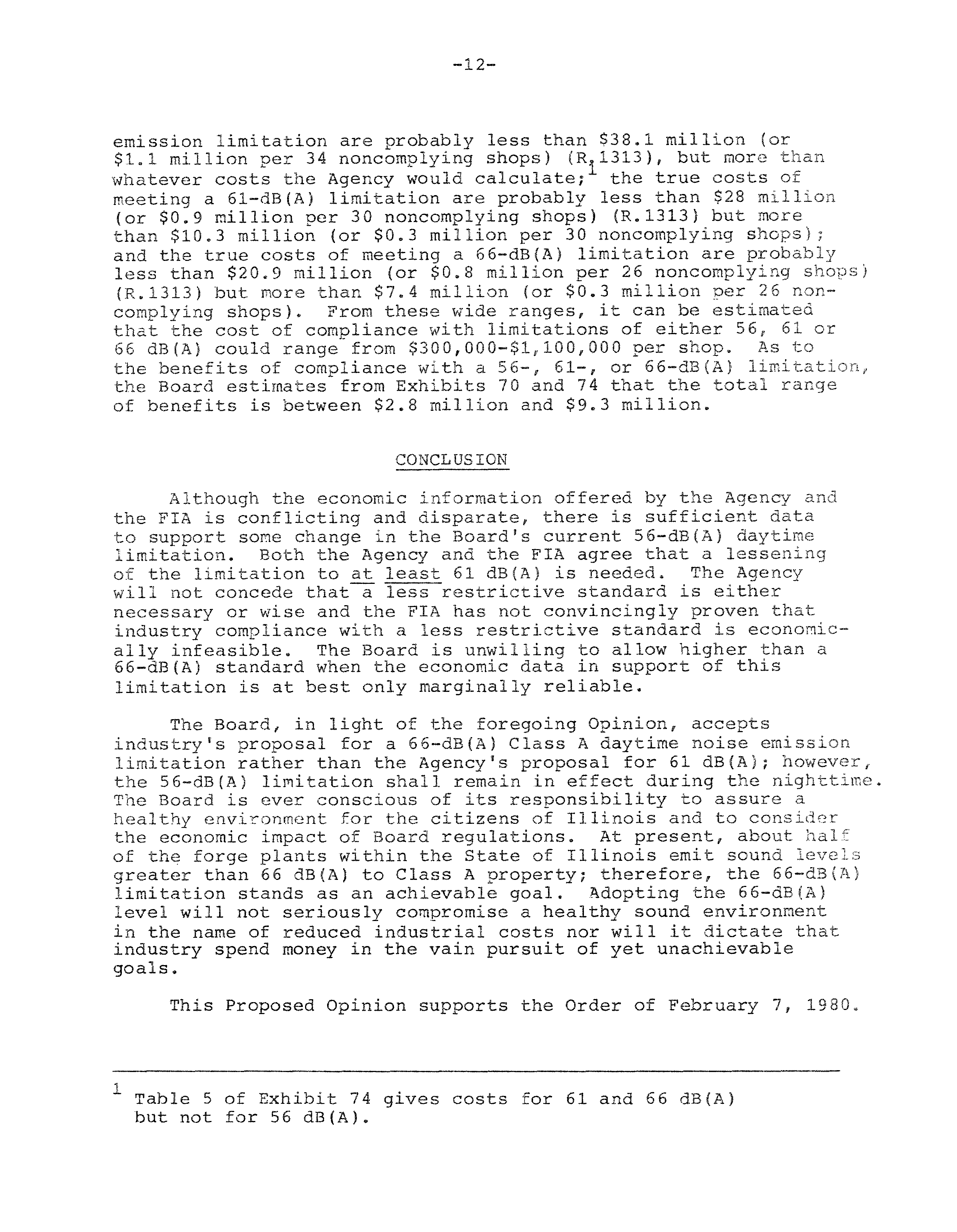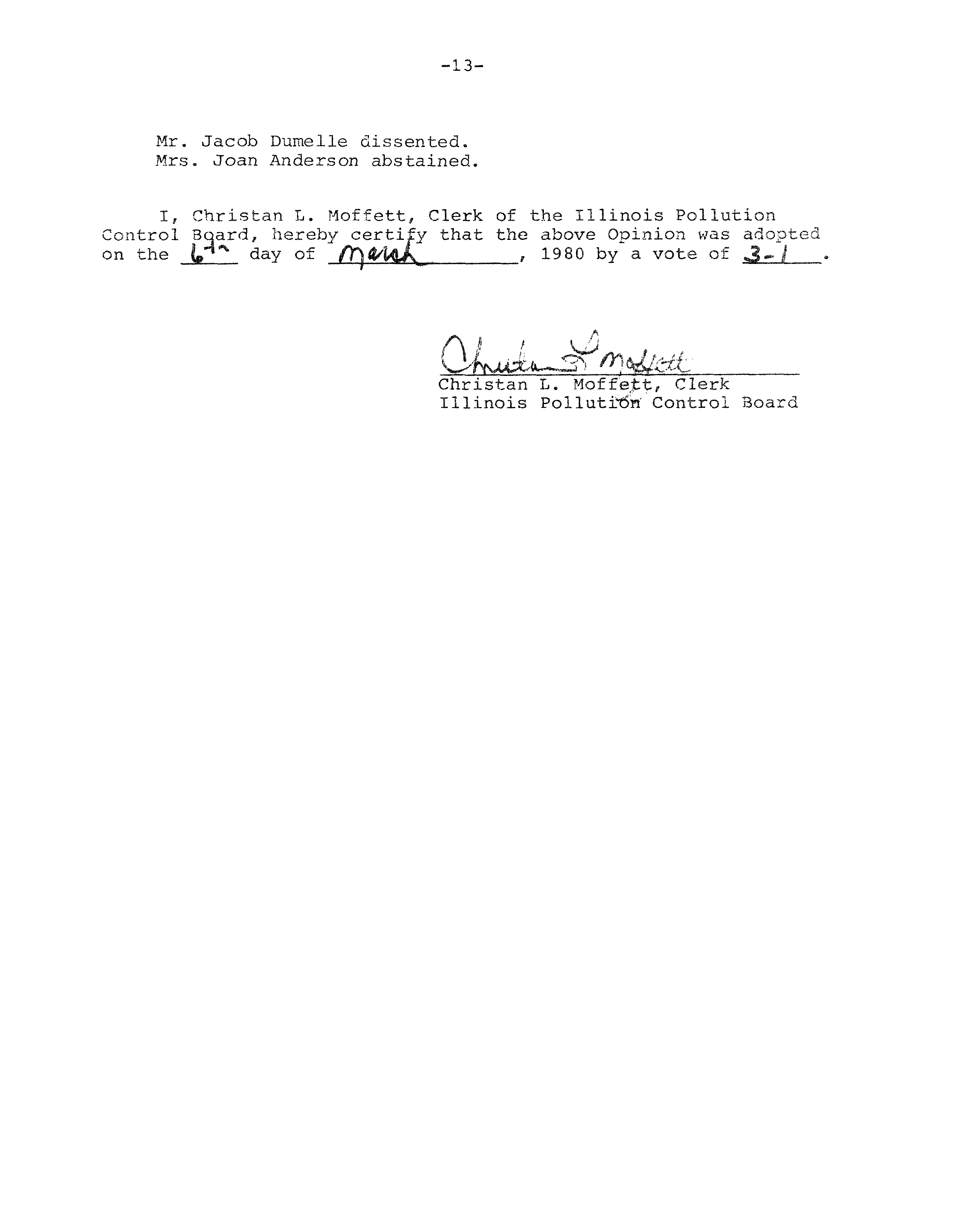ILLINOIS POLLUTION CONTROL
BOARD
March
6,
1.980
IN
THE
MATTER OF:
PROPOSED
AMENDMENT
of RULES 101,
R76—14 and
205,
206 and 209 of the NOISE
R76—19
REGULATIONS
PROPOSED OPINION OF THE
BOARD
(by Mr. Goodman):
The Forging Industry Association (FIA)
and
thirty indi-
vidual forging companies on July 2, 1976 petitioned the
Board to adopt, by amending Rules 101 and 206 of the Board’s
Noise
Pol lution
Control
Regulations
(Noise
Regulations),
certain
emission
limitations
and
other
requirements
with
respect
to
new
and
existing
impact
forging
operations
(Industry
Proposal).
Proponents
alleged
an
inability
to
comply
within
three
years
of
the
effective
date
of
Rule
206
as
allowed
by
Rule
209(h)
of
the
Noise
Regulations.
The Illinois Environmental Protection Agency (Agency)
on August 23, 1976 also petitioned the Board to amend Rules
101,
206 and 209 with respect to
new
and existing impact
forging operations and to delete Rule 205 regulating sound
emissions to Class C land receivers.
On October 14, 1976
the Board ordered the Agency proposal to be treated as a
separate proposal, docketed R76—19,
but
cpnsolidated with
R76-14 for purposes of hearing and decision.
The following
public hearings were held:
)
)
)
)
)
September
22,
1976
November
4,1976
December 13, 1976
December 14,
1976
February 15, 1977
February
16,
1977
May 2,
1977
May 3,
1977
December 18,
1978
December 19,
1978
February
21,
1979
September 12,
1979
Chicago
Springfield
Chicago
Chicago
Chicago
Rockford
thicago
Chicago
Rock
ford
Rockford
Chicago
Chicago
The Board acknowledges the assistance of Carolyn S. Hesse,
Technical Assistant, in the drafting of this Opinion, and the
assistance of Roberta Levinson in serving as Hearing Officer.
—j)—
The latter
four
hearings were economic impact hearings.
Prior
to those hearings,
the Illinois Institute of Natural
Resources filed economic impact studies regarding the
proposed rule changes, Document No.
78/03, The
Economic Impact of Proposed Forging Noise Regulations
(R76-14,—19), and Document No.
78/36, Economic Impact
of
Removing Numerical Limits on Sound Emissions to
Class C Land
(R76—19).
These studies were filed
in
accordance with Section
6 of the Environmental Protection
Act.
HISTORY OF
THE
REGULATIONS
On July
26,
1973,
the Board adopted Chapter
8:
Noise
Regulations.
Included in those regulations are Rule
205,
Sound Emitted to Class C Land,
and Rule 206, Impulsive
Sound, which are the subject of
these proceedings.
Both the
Agency and Industry Proposals suggest changes
to Rule 206
which would allow higher sound levels to be emitted to Class
A (primarily residential
use) and Class B
(primarily certain
types of business
use) receiving lands,
Regarding emission
levels from existing forging operations
to Class A land,
industry seeks a 66-dB(A) limitation while the Agency seeks
a
61—dB(A)
limitation.
Both Proposals agreed on emission
levels to Class B land and on emission levels from new
operations
to Class A lands.
The Agency proposed deleting
Rule 205 entirely;
at hearing, industry witnesses concurred
with this deletidn.
The Proposed Order adopted on February
7,
1980 amends
Rules
101,
205,
206 and 209 as follows.
To the definitions
in Rule
101 have been added definitions for A—weighted sound
level and fast dynamic characteristic.
Definitions
for
dB(A)
and sound
level are deleted.
These definition changes
clarify those rule changes which were proposed for adoption.
Rule
205
is deleted.
Rule
206,
Impulsive Sound,
(1) deletes
the limitations
on impulsive noise emitted to Class C land;
(2) increases
the
allowable
impulsive noise levels emitted
from forging operations to Class A and Class B lands;
and
(3) adds
a provision grandfathering the existing use
classifications
of
land located within 1000 feet of the
property line of a forge plant,
thus establishing which
classification
is to be used for purposes of enforcing this
regulation,
unless
a subsequent
land use classification at
the time of new forge plant construction would allow a
less
restrictive limitation to apply.
Rule 209 specifies the
dates by which sources are to comply with Rule 206.
—3—
ANALYSIS
OF
THE
REVISED
REGULATIONS
Class
C
Receiving
Lands
(R76-19)
Virtually none of the evidence produced a~the merit
hearings supported maintaining Rule 20.
The primary reason
for having a Class
C sound limitation is to protect Class C
property receivers from levels which interfere with
conversations held at one— to three—foot distances or with
using
a telephone
(R.420).
The Board agrees that Class C
lands require
less protection than either Class ~ or Class B
lands
require because
the types of activity conducted on
Class
C
lands are less noise sensitive
(R.1083),
Since
Class
C
lands are typically used for manufacturing
operations
(R.1084),
they usually contain sources which emit
higher sound levels within their own property than they
receive from other property
(R,1082).
Class C land
operations emit within their property lines sound levels far
in excess of the limitations permitted in Rule
205
(R,1082).
Unoccupied farm land
is also classified
as Class
C
land,
However, over the years
the Agency has received very
few complaints
from Class C farm land receivers,
Only up to
3
of Class C receivers are bothered to any degree by noise
from any source.
It
is clear from the economic impact study
concerning these rule changes and from the evidence
in the
record that removing limitations affecting Class C receivers
would not regulate the major sources
of disturbance to these
receivers, which are nonstationary sources,
The Board~s
current Rule 102 is adequate
to enforce noise pollution
violations
in these situations
(R.1085—1086).
Sound Levels Emitted From Forge Plants
(R76—14)
During hearing,
there was much testimony
from
representatives
of the forging industry that meeting
original Rule 206,
adopted
in 1973,
is not technologically
feasible.
Noncompliance
is primarily due to the absence of
known methods of controlling the impact, or impulsive,
sound
emission levels from forge hammers at their sources.
The Noise Control Task Force
(NCTF).through the Forging
Industry Education and Research Foundation
(FIERF) performed
an extensive, three—volume study of existing forge plants to
determine the sources
of sound emissions and ways
of
controlling them
(Exhibits
16,
17 and 18),
Based on this
study,
it appears that the noise
is being caused by two
effects.
The first and primary contributor
to the peak
sound
level
is the sound generated when the ram,
driven
downward,
hits the metal work piece
(billet) and the die on
the anvil.
The second source of sound is caused by the
vibration of the ram and the columns which guide
it downward
—4—
due
to
the
sideways
movement
of
the
ram
between
the
columns
after
it
hits
the
die.
Since peak sound pressure levels are generally
proportional to blow strengths, reducing the blow strength
would reduce the
peak
sound level; however,
it would also
derate the hammer
(R.310).
There may be some operations in
which the
hammer
blow is stronger than necessary and could
be derated (R.319), but in the majority of forge shops derating
may
not be feasible.
In the
FIERF
study, shrouding the hammer was studied,
but
this nay cause several problems:
1.
If blow strength is reduced, the hammer would not
be able to produce the part.
2.
Since the columns maintain the die alignment,
to
reduce the columns’ vibrations by isolating them
from the
ran
before the
ram
strikes the work piece
may cause malalignment (R.322).
3.
The openings in retrofitting
any
shroud or enclosure
will need to be minimized in order to reduce the
amount of noise radiating past the treatment
(R.323).
Openings
are
necessary for access to the work piece.
4.
Dynamic
stresses in the shroud would have to be
minimized for safety
(R.323).
5.
In some cases a
ram
shroud could never be used due
to the given relationship between the
ram and
the
columns.
The buildings in which forge shops are operated are gen-
erally open structures which were not designed to reduce the
amount of sound radiating to the neighborhood.
A forge plant
must have adequate ventilation because of the amount of heat
generated inside the plant.
Consequently,
the structures were
designed with roof
and
side openings to provide natural ventila-
tion to dissipate the heat (R.103).
All of the forge plants
discussed
in
the
record
are
hot
forge
plants.
The
work
material,
typically
steel,
is
heated
to
around 2200°Fso that the material
is plastic enough to forge, since it cannot be forged while cold
(R.105—106).
After forging, the hot material is
put
onto skids,
and
when the skid is filled, it is usually moved outside to cool
(R.1043).
In addition to the skids loaded with hot material
(R.1044), the furnaces used to heat the material are major
sources of heat inside the plant (R.106).
The level of sound emissions radiated from some forge shops
can be reduced by 15 dB(A) by closing the open windows and doors
• or by covering them with silencers
(R.517).
Additional noise
reductions can be obtained by making structural changes in the
—5—
building,
such
as
repiacinq
a
plain
metal
roof
t-Ieck
with
one
made
with
asbestos—containing
material,
replacing
sheet
metal
walls with brick or concrete blocks,
and
replacing
plain
glass
windows with double glass windows.
However,
in
a typical, existing,
unimproved
forge
shop,
only about 4
of the acoustical energy which radiates
to the
outside does
so through the structure
itself; the remaining
96
radiates through
the openings
(R.523).
Hence,
it appears
that
covering the open doors with silencers
or other material would
be an effective way
of reducing the energy radiating from the
shop (R.523).
As the openings are reduced, or covered, however,
the need for mechanical ventilation increases as the natural
ventilation
is reduced or eliminated.
Tn addition,
there is a
need
for openings so
that vehicular and other traffic
is not
prevented
(R.502—503).
An additional
method
of
reducing
the
amount
of
noise
radiated to the neighborhood
would
he
to use barriers
such as
walls or berms.
Barriers placed 10-15 feet outside the peri-
meter of
a building can achieve
a 10— to 15—dB(A) reduction in
sound emission levels
(R.499—501).
Barriers must reach higher
than the openings in the plant wall
to be effective
(R.1119).
Barriers,
however, can interfere with necessary vehicular and
other traffic
(R.49~9—501),
may
reduce ventilation
(R.1064—1066),
and may he prohibited by nonownership of the requisite property
(R. 499—501).
There was evidence that
technological improvements
in
controlling
sound emissions are umovingr~ (R.1054—1055).
The
Danville Wyman—Gordon plant, which owns and operates the
largest forge and hammer shop in the country
(R.1028—1030),
operates an entirely different technological approach to the
manufacture of crank shaft forgings and alleges
it experiences
no noise problems
(R.1037).
There was also evidence that
a
6,000-pound
hammer
equipped
with
a hydraulic Lasco head was
quieter than other 6,000—pound hammers
(R.972—976).
Det~rminationof Allowable Sound Emission Levels
Impulsive noise affects people who hear
it by interfering
with speech and hearing and with degree of relaxation; when
it
exists at night it can interfere with sleep.
One witness testi-
fied that impulsive noise interferes more with
the
ability to
relax than does steady state, or background,
noise, hut that
steady state noise interferes more with speech than does impul-
sive noise
(R.1219).
There
is
no evidence in the record of the
relative importance to human health or welfare of relaxation,
speech, hearing,
sleeping,
or other activities.
Existing
impulsive sound emission levels of drop forge
hammers are estimated to range as high as
121
dT3(A)
for
a
1000—
2,000
pound
hammer
(R.240—241).
The
typical
hammer
operates
at
—6—
500—20,000 blows per shift
(R.245).
The average time between
hammer strikes
is one to
three seconds
(R.439).
According
to the record, present daytime sound emission
levels result in the situation that roughly
60
of the 45
forge plants are not complying with present Rule 206
(R.486).
The present daytime limitation of
56 dB(A)
is
exceeded by 62
of all plants; the limitation of
61 dB(A)
by
53
of all plants; the limitation of
66 dB(A)
by 44
of all
plants,
the limitation of
72—76 dB(A)
by
9
of all plants,
and the limitation of
82 dB(A)
and higher by
9
of all
plants
(R.1000).
There was also testimony
that 58
of
the plants could meet a limitation of
66
d13(A),
and 48
could meet 61 dB(A), at the present time
(R.579-580,
583).
There was evidence that 95
of all plants could meet
a
limitation of
66 dB(A) with an emission improvement of
between
5 and 20 d13(A),
and
1
of the plants would have to
improve their emission levels by
35 dB(A)
to reach this
limit
(R.542—544).
The Agency presented data of
sound emission levels from
all 45 forge plants
in Illinois
(Ex.56).
At one of the
shops it tape recorded the sound level
of a 2,000—pound drop
hammer
(R.1013).
This tape was played back through a sound
level meter
into
a strip chart recorder to determine which
measurement mode would be the most appropriate for measuring
the impulsive noise (R.1013—1014).
It concluded that the A
fast measurement mode was the most nearly accurate
(R.1021),
both because the A—weighted network most closely
approximates the way the human ear perceives sound and
because the A fast measurement mode was able to detect from
140 hammer impulses
all
impulses, whereas the A slow
measurement mode detected only
76 of them (R.1015).
There was considerable testimony which tried to relate
maximum A—weighted fast response sound levels to the energy
equivalent sound level, or
L
level,
a time—weighted
average which can he express~ in dB(A)tS.
Sound levels
expressed in terms of L
are useful
in estimating
effects
on the health and welfa~ of persons exposed
to them.
However,
for purposes of enforcing
a regulation
limiting
impulsive sound emissions,
the Board finds that the most
appropriate method is the use of A-weighted
sound levels,
measured with the fast dynamic characteristic.
Rule 206(d)
provides that for purposes of enforcing Rule
206 only certain land use classifications
in effect shall he
the applicable
land use classifications
unless subsequent
changes would result in applicability of less restrictive
limitations on the impact forging operation.
This rule is
included
so that forge plants will not be penalized
if a new
use classification would require reductions
in sound emission
—7—
levels.
The Industry Proposal specified a distance of one
mile from the property line.
However, the
Board
believes
that one mile would be an excessive distance; the distance
of 1000 feet was selected because the Board believes that,
since sound levels are attenuated by 20 dB(A) at 1000 feet,
this distance is sufficient
(Ex.27).
ECONOMIC EVIDENCE
R76—19
(Illinois Institute of Natural Resources’ economic impact
study (Study—19), Doc. No. 78/36, June, 1979.)
Study-19 concludes that the benefits of removing the limita-
tions are approximately three times as much as the costs which
would be entailed.
Benefits are comprised primarily of industry’s
avoided costs of sound abatement and of the state’s avoided costs
of enforcement of the limitations.
Specific costs and benefits of
control technologies are the same as those set forth in its study
concerning R76-14
(Study—14) to the extent they concern forge
plants.
Since 14 forge plants were out of compliance with only
the regulation regarding emissions to Class C receiving land,
repealing that regulation would save those sources compliance
costs
(R.162).
No evidence was produced at hearing of the costs to owners
or operators of farm land to control their sound emissions to
other Class C lands.
R76-14
(Illinois Institute of Natural Resources’ economic impact
study (Study—14), Doc. No.
78/03, October,
1978.)
The author of Study—14 chose three measures of cost.
One
measure was “base case” estimates of cost to the entire forging
industry.
These costs, however,
could be twice as high as true
costs would be.
The second measure was estimates of cost to all
plants of reducing emissions by 6 dB(A).
These figures are similar-
ly subject to error.
The third measure was estimates of cost to
10 particular plants,
both
individually and in the aggregate
(Ex.70,
p.iv.).
The author relied on data derived by Bolt, Beranek and
Newman,
Inc.
(BBN) to develop adjusted statewide cost estimates
and, from these estimates,
the base case estimates.
Although
there is considerable diversity among plants, BBN statistics were
not derived on a pjant-by-plant basis but rather from a model
(Ex.70, pp.11—13).
1 Six architecturally representative plants, including complying
plants and multiple shop plants, were used to identify fourteen
distinct elevations which were examined as representative of
all shop elevations.
From this examination a reference struc—
—8—
Benefits of
sound emission reduction were calculated by
analyzing the distribution
of homes around plants and studies
regarding the contribution of sound emission levels
to differen-
tial property values
(Ex,70, pp.iv—v).
Although benefits can
be measured by monetarizing physical effects of sound on human
life and human activities,
and have been covered extensively—
in literature,
the author did
not
include these physical effects
in his assessment
of benefits.
He instead measured benefits in
terms of damage to transactions engaged
in “in which, implicitly,
we place a value on
reduced
noise”;
buying a house was singled
out
as one
of these transactions,
(Ex,70, p.58).
The author then provides discussion of various mathematical
equations expressing
the relationship among characteristics
determining the value of a house to the desirability of these
characteristics——that
is, that the value of a house
is
a function
of these characteristics.
One of these equations was utilized
by John
P. Nelson and derived from data of the Washington,
D,
C.
SMSA; another was utilized by Roger J, Vaughn and Larry Huckins
and derived
from Chicago area traffic noise data
(Ex,70,
pp.58-60)
Although these authors used different values for the noise index
variable
in the equation, the regression coefficient derived by
both,
used in conjunction. with the variable~s contribution
to the
equation,
was the same
(Ex,70,
pp.61—64).
However,
the Study—14
author
used
a
second
BBN
report
to
adjust
the
equation
to
account
for
the
frequency
of
forge
hammer
strikes
in
the
noise
index
as
represented
by
the
relationship
L0
A—weighted
fast
-
5
dB(A).
This
may
have contributed to
an
un~erestimation
of
benefits
(Ex,70,
p.64—65).
The author gathered data for the benefits equation by
studying data developed by ETA Engineering,
Inc.
on 10 plants
and developing a statewide model,
From noise contour zones
drawn according to the emission levels of these
10 plants,
extrapolation to the
26 noncomplying
(at 56 dB(A)) plants was
made,
e.g.,
the number of
houses
within
each
contour
was
increased by
26/10.
This new number
of houses within each
contour was divided by the number of plants emitting at
levels
equal
to or greater than the levels given
for each contour.
For
each plant was then derived how many houses were affected by
ture
(typical shop) was developed and control costs derived
from those control
methodologies judged to he applicable at
each 5—dB increase.
Costs of the applicable methodologies were
“estimated with the
aid
of
...
data supplied by
Holahird
and Root.
The
frequency of applicability of each method
was
determined by reference to the actual characteristics of-
the
14 distinct elevations,”
Finally BBN costs were esti-
mated based on the incidence
and
degree of noncompliance
among shops as determined by an incomplete
ETA,
Inc.—Michigan
Technological University survey although the author utilized the
completed data when it became available
(Ex.70,
pp.13—14).
—9—
that
plant.
The
objective
was
to
measure
‘how
much sound reduc-
tion
would
accrue
to
the
houses
for
given
noise
reductions
by
the plants
(Ex.70,
pp.66—67).
Finally,
the author weighed the cost—benefit ratio achieved
(1)
by designing
a variant case where costs were assumed to be
50
lower than was calculated and benefits to he 70
~~er
than
was calculated; and
(2) by comparing data applicable
to the 10
plants used
to derive cost estimates,
In both analyses the author
found costs generally
to exceed benefits
(Ex.70, p.v).
In determining the percentage
of noncomplying ~os,
all
shops
of a given plant were treated as
if they emitted
the
sane
level
of
sound
Ex,70,
p.8).
Thus estimates
of how many
Illinois shops are not presently complying with the limitation,
as well
as how many could not comply with various proposed
limitations, may be inaccurate,
An accurate evaluation of
the economic reasonableness
of any
proposed reduction from the present 56 dB(A)
level
is difficult
based on Study—14 and the entire hearing record,
Essentially,
the author states that costs exceed benefits
at any level
(including the present one)
(R,1319—1320),
and the Agency states
that benefits exceed costs
at any level
(R.1619),
Even though
cost—benefit comparisons are factors
in determining the reason-
ableness of an economic impact,
they are not the only
factors
which should be considered.
The disparity between the author~s
and the Agency~s conclusions,
supported in part by witnesses
Croke and DeGraff,
is illustrated below.
Costs,
The Agency states
‘that the author’s costs should
he revised downward because
(1) the least—complying plant
in
a group was used as
the compliance cost model for each plant
within the group
(groupings were made according to actual emis-
sions)
(R,1678)
(see post);
(2)
lighting costs are 75
lower
than the costs used by the author
(R,1569);
(3) the method of
amortization of control costs,
the estimate of the number of new
or modified pieces of ventilatIon equipment needed,
and the esti-
mate
of fuel consumed
to maintain inplant temperatures
all over~-
estimate operating costs
(R,1572—1575);
(4) silencers coupled
with natural ventilation systems were not considered
(R,1562-1565,
1682,
1697);
(5) reduction in ventilation sizings will reduce
mechanical ventilation system costs
(R,1565;
and
(6)
costs
of
barriers
are two times too high
(R.1560—1562,
1644),
The Agency,
however,
does
state that the author properly considered engineer—
ing and consultant
fees
(R,1686—1689).
Conversely,
the author states that the Agency’s costs
should
ho revised upward because
(1) costs
of
nighttime operations are
excluded;
(2) the increased closing
of ventilation openings will
raise inplant noise and necessitate additional costs; and
(3)
costs of stopping production
to effectuate control technology
are excluded
(R.1769—1770).
The author,
however,
does say that
—10—
the Agency’s
costs
should be revised downward because of the
data used in arriving at natural
and
mechanical ventilation
equipment and lighting (R.1763—1767).
Benefits.
The Agency states that the author’s benefits
should be revised upward because
(1) property values were
underestimated by a factor of 2.63
(R.1613, 1635);
(2) home
buyers are unaware of sound emission effects in the
environment
until
they
have
lived
in
the
home
for
a
period
of time (R.1580—1584);
(3)
airport
noise
studies
raise
questions as to effects on fetuses
(R.1715);
(4) the traffic
noise index used underestimated damages (R.1587—1592);
(5)
the Vaughn and Huckins study and model produced
statistically nonsignificant results, including an under-
estimation of benefits by one—half of what other models have
yielded (R.1594-1598);
and
(6) personal health effects
benefits are not considered
(R.1788).
Conversely, the author states that the Agency’s
benefits should be revised downward because
(1) homes which
are mobile should not reap full benefits and
(2) if plants
could not meet a 50—dB(A) level, benefits would be illusory
(R.1771).
The author, however, states that in some areas
the Agency’s benefits would exceed costs by a factor of 2
(R.1786).
In
trying
to
summarize
the
disparity
between
the
cost
and
benefit
estimates
made
by
the author and the Agency, the
Board
looks
to
testimony
of
these
participants
themselves
regarding
the
merits
of
their
own
studies.
First,
the
Agency nowhere in the record states that its benefit figures
are
overstated.
The
Agency
admits
its
cost
figures
are
understated to the extent that data supplied to it
specifying the percentage of wall surface areas which
openings comprise were based on a plant’s having one wall
with openings and not two, three, or four walls with
openings
(R.1700,
1827-1828).
However, this does not mean
that the figures are inaccurate by some factor of 2,
3, or
4,
but
rather that the per wall percentage of openings
figure used may not be as representative as if a percentage
had
been
derived
from
measurements
taken
from
all
four
walls.
This
does
not
appear
to
be
a
significant
error
statistically when the Agency’s study is taken as a whole.
In addition, however, the Agency’s cost figures for barriers
may not have included costs of labor
(R.1648); this error
would make the barrier cost estimates tob low but not
statistically
unreliable
except
in
isolated
cases.
The
second
point
the
Board
notes
from
the
record
is
that
the
author’s
cost
figures
may
be
overstated
for
additional
reasons:
(1)
payroll
and sales figures are too
high
because
if
figures
for
complying
plants
had
been
included, per plant figures would be about 40
less
(R.1359—1361);
(2) costs of automobiles manufactured by
—11—
companies not using only Illinois forgings would be lower
(11.1404—1405);
(3) the increased price of forgings was based
on the assumption that competition among forge plants would
not prevent any increases from being passed on to the consumer
(R.1533, 1548—1549);
(4) the average area of an elevation is too
large by at least 35
(R.1314); and
(5) the use of silencers will
produce lower costs than stated (R.1314).
It should be noted
that the author himself states that the cost figures should be
used for ‘benchmark purposes’
(R.1313).
These reasons, however, are much less significant than
the further reason, pointed out by both the Agency and the
author, that the measure used to derive costs of sound emission
reductions was not the actual decibel decrease necessary but
the approximate decrease.
The decibel decrease upon which costs
were then calculated was overestimated in this manner:
plants
were grouped into ranges of their actual emission levels, e.g.,
87—91 dB(A), and costs calculated for all plants in those ranges
based upon the given that all plants actually emitted at the
upper level, or 91, rather than at the lower level, or 87, or at
any intermediate level
(11.1314,
1371—1375, 1678).
This error
overestimates costs for all plants in the lower range of each
grouping.
Further, the choice of actual emission levels influences
both the degree of emission reduction necessary and the type of con-
trol technology which would be feasible and, therefore, the extent
of costs to be incurred.
Lastly, the Board finds in the record several questionable
assumptions which appear to have been made, and some not to have
been made.
The author assumed
(1) buyers and occupiers of homes
differ in their valuation of benefits of sound reduction, e.g.,
a buyer or occupier of a $50,000 house values sound reduction
twice as much as a buyer or occupier of a $25,000 house
(11.1415—1423);
(2) annoyance occurs primarily from single,
defined
emissions
rather
than
multiple
or
repetitious
emissions
(R.1425—1432,
1557);
(3)
hearing
loss
is
not a significant enough
factor
to
be
taken
into account
(11.1479);
(4) outside research of
the effects of noise pollution other than those in the hearing
record would not have uncovered additional effects
(11.1481—1482).
Finally, the author’s benefit figures excluded benefits which
could accrue to hospitals and physically immobile persons (11.1555-
1559), to employment in the noise control abatement industry
(11.1534-
1536), and to citizens due to the technology—forcing policy of the
Illinois Environmental Protection Act (Section 2)
(11.1485—1488).
It is clear to the Board from the testimony and documents
in the record that cost and benefit figures cannot be relied
upon with any reasonable accuracy.
Therefore, it may not
be true,
as the author asserts, that costs will be greater
than benefits in every instance.
Neither does the Board find,
as
the
Agency
asserts,
that
benefits
will
be
greater
than
costs
in
every
instance.
This means that the true costs of meeting a 56 dB(A)
sound
—12—
emission limitation are probably less than $38.1 million (or
$1.1 million per 34 noncomplying shops) (R~1313),but more than
whatever costs the Agency would calculate;’ the true costs of
meeting a 61—dB(A) limitation are probably less than $28 million
(or $0.9 million per 30 noncomplying shops)
(R.1313) but more
than $10.3 million (or $0.3 million
per
30 noncomplying shops);
and the true costs of meeting a 66—dB(A) limitation are probably
less than $20.9 million
(or $0.8 million
per
26 noncomplying shops)
(11.1313) but more than $7.4 million (or $0.3 million per 26 non-
complying
shops).
From these wide ranges,
it
can
be estimated
that the cost of compliance with limitations of either 56, 61 or
66 dB(A) could range from $300,000—$1,100,000 per shop.
As to
the benefits of compliance with a 56-, 61—, or 66—dB(A) limitation,
the Board
estimates
from
Exhibits
70
and
74 that the
total
range
of benefits is between $2.8 million and $9.3 million.
CONCLUSION
Although
the
economic
information
offered
by
the
Agency
and
the
FIA
is
conflicting
and
disparate,
there
is
sufficient data
to
support
some
change
in
the
Board’s
current
56—dB(A)
daytime
limitation.
Both
the
Agency
and
the
FIA
agree
that
a
lessening
of
the
limitation
to
at least 61 dB(A) is needed.
The Agency
will
not
concede
that
a
less
restrictive standard is either
necessary
or
wise and the FIA has not convincingly proven that
industry compliance with a less restrictive standard is economic-
ally infeasible.
The Board is unwilling to allow higher than a
66—dB (A) standard when the economic data in support of this
limitation is at best only marginally reliable.
The Board, in light of the foregoing Opinion, accepts
industry’s proposal for a 66—dB(A) Class A daytime noise emission
limitation
rather
than
the
Agency’s
proposal
for
61
dB(A);
however,
the
56-dB(A)
limitation
shall remain in effect during the nighttime.
The
Board
is
ever
conscious
of
its
responsibility
to
assure
a
healthy environment for the citizens of Illinois and to consider
the economic impact of Board regulations.
At present, about half
of the forge plants within the State of Illinois emit sound levels
greater than 66 dB(A) to Class A property; therefore, the 66—dB(A)
limitation stands as an achievable goal.
Adopting the 66—dB(A)
level will not seriously compromise a healthy sound environment
in the
name
of reduced industrial costs nor will it dictate that
industry spend money in the vain pursuit of yet unachievable
goals.
This Proposed Opinion supports the Order of
February
7,
1980.
Table
5 of Exhibit 74 gives costs for 61 and 66 dB(A)
but not for 56 dB(A).
—13—
Mr. Jacob Durnelle dissented.
Mrs. Joan Anderson abstained,
I,
Christan
L.
Moffett,
Clerk
of
the
Illinois
Pollution
Control
B~ard,
hereby
certi y that the above Opinion was adopted
on the
1,
~
day of
ft~4i
,
1980 by a vote of
~3~4
Christan L. Moffe~t,Clerk
Illinois Po1iutt~ Control Board


